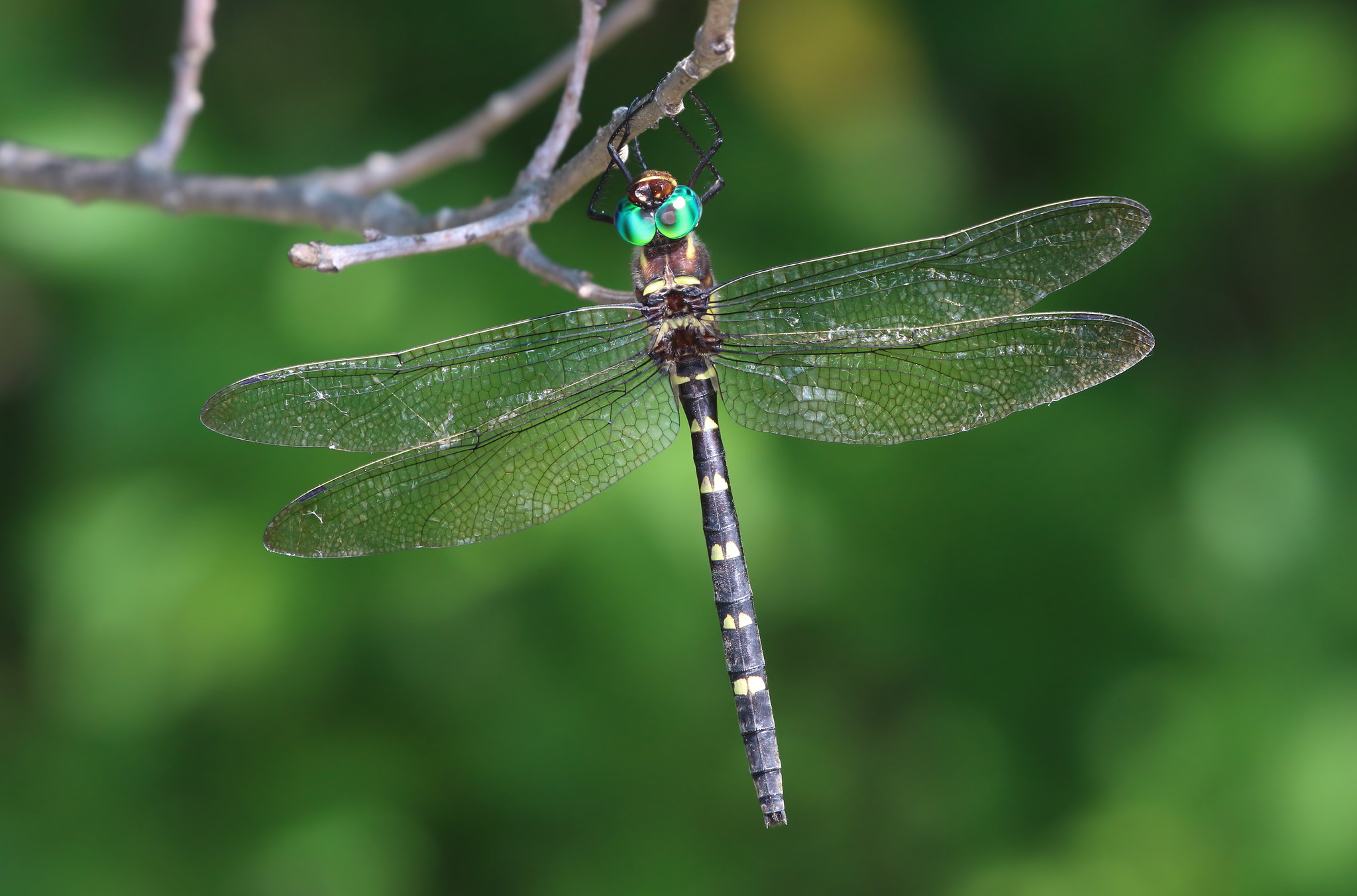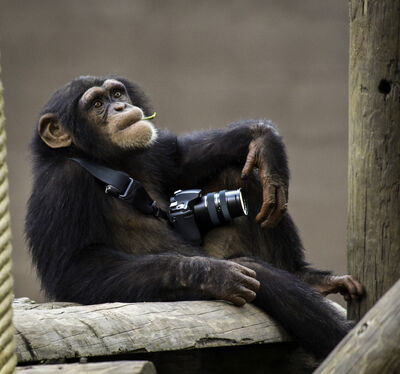Dragonfly summer IV
Apr 7, 2020 02:41:43 #
Here are more pictures of dragonflies, and related insects called damselflies.
In the first picture is one of my favorites, although it is quite common. This is a young male Eastern pondhawk (Erythemis simplicicollis). Like many dragonflies, males start out with colors that are similar to females, but as they mature their color changes in some way. In the case of this species, male Eastern pondhawks develop a pale blue color, and that is just forming here. I like this intermediate look.
 Eastern pondhawk by Mark Sturtevant, on Flickr
Eastern pondhawk by Mark Sturtevant, on Flickr
Dragonflies are often provided with cool common names. There are pennants, cruisers, meadowhawks, pondhawks, and so on. One of the most spectacular of our dragonflies is Hagenius brevistylus, but it has an especially impressive common name: “dragonhunter”, and one is shown here. This is a male, and I gladly spent the better part of an entire outing just staking out this one twig, waiting for him to land on it.
 Dragonhunter dragonfly by Mark Sturtevant, on Flickr
Dragonhunter dragonfly by Mark Sturtevant, on Flickr
Dragonhunters are not quite our largest dragonfly – but they are pretty close!. Their large size and striking patterning always draws attention wherever they go. The common name is appropriate, as these dragonflies mainly eats large insects including other dragonflies. They are not particularly interested in mosquitoes!
In a previous post I included a species known as royal river cruisers (Macromia taeniolata). Last year I had a rather amazing encounter with a pair of perching females of this species. This was very surprising!
 Royal river cruisers! by Mark Sturtevant, on Flickr
Royal river cruisers! by Mark Sturtevant, on Flickr
 Royal river cruisers by Mark Sturtevant, on Flickr
Royal river cruisers by Mark Sturtevant, on Flickr
 Royal river cruiser by Mark Sturtevant, on Flickr
Royal river cruiser by Mark Sturtevant, on Flickr
Although technically not dragonflies, damselflies are from the same order of insects and so are similar in anatomy and biology. Damselflies typically rest with more vertical wings, and their heads are dumbbell shaped. Here are some damselflies.
My favorite damselflies are those in the ‘broadwing’ family. These are larger than most damselflies. We have two broadwings that are common in my area, and they include the extraordinary ebony jewelwing damselfly (Calopteryx maculata), as shown here. This is a male. Females are not as deeply colored, and they have white markings on their wings.
 Ebony jewelwing by Mark Sturtevant, on Flickr
Ebony jewelwing by Mark Sturtevant, on Flickr
I am still trying to figure out jeweling photography. They are common along forest trails, and so are likely to be in the shade. But their metallic color is fairly ruined when photographing with a flash, and yet supplemental lighting is very helpful in bringing out details. I am still fussing with how best to solve this issue. In this case, the insect was sitting in filtered sunlight and it was photographed at very low flash power at a wider aperture. These settings allowed me to focus stack two pictures, and this is the result. Maybe a reflecting dish might help. I am certainly open to suggestions!
Another broadwing species is the American rubyspot damselfly (Hetaerina americana). This first picture is a mature male, and it took a couple trips to the riverbank in the late afternoon to get one with low sunlight passing through the wings.
 Rubyspot damselfly by Mark Sturtevant, on Flickr
Rubyspot damselfly by Mark Sturtevant, on Flickr
Here is young male that has not yet fully developed its breeding colors.
 Immature male ruby spot damselfly (Hetaerina americana) by Mark Sturtevant, on Flickr
Immature male ruby spot damselfly (Hetaerina americana) by Mark Sturtevant, on Flickr
The last picture is of more American rubyspots. Here a female is eating another damselfly that had recently emerged from the water, pale and defenseless. Damselflies are dainty creatures, but like all Odonates they are dedicated predators! Meanwhile a male stands guard in the background. He will chase away intruder males while also seeking to mate with females who enter his river-front territory. The river itself, by the way, is the Flint river. It gets a lot of negative news, but actually the river is beautiful and teaming with life.
 American rubyspot damselfly by Mark Sturtevant, on Flickr
American rubyspot damselfly by Mark Sturtevant, on Flickr
Thank you for looking!
In the first picture is one of my favorites, although it is quite common. This is a young male Eastern pondhawk (Erythemis simplicicollis). Like many dragonflies, males start out with colors that are similar to females, but as they mature their color changes in some way. In the case of this species, male Eastern pondhawks develop a pale blue color, and that is just forming here. I like this intermediate look.
 Eastern pondhawk by Mark Sturtevant, on Flickr
Eastern pondhawk by Mark Sturtevant, on FlickrDragonflies are often provided with cool common names. There are pennants, cruisers, meadowhawks, pondhawks, and so on. One of the most spectacular of our dragonflies is Hagenius brevistylus, but it has an especially impressive common name: “dragonhunter”, and one is shown here. This is a male, and I gladly spent the better part of an entire outing just staking out this one twig, waiting for him to land on it.
 Dragonhunter dragonfly by Mark Sturtevant, on Flickr
Dragonhunter dragonfly by Mark Sturtevant, on FlickrDragonhunters are not quite our largest dragonfly – but they are pretty close!. Their large size and striking patterning always draws attention wherever they go. The common name is appropriate, as these dragonflies mainly eats large insects including other dragonflies. They are not particularly interested in mosquitoes!
In a previous post I included a species known as royal river cruisers (Macromia taeniolata). Last year I had a rather amazing encounter with a pair of perching females of this species. This was very surprising!
 Royal river cruisers! by Mark Sturtevant, on Flickr
Royal river cruisers! by Mark Sturtevant, on Flickr Royal river cruisers by Mark Sturtevant, on Flickr
Royal river cruisers by Mark Sturtevant, on Flickr Royal river cruiser by Mark Sturtevant, on Flickr
Royal river cruiser by Mark Sturtevant, on FlickrAlthough technically not dragonflies, damselflies are from the same order of insects and so are similar in anatomy and biology. Damselflies typically rest with more vertical wings, and their heads are dumbbell shaped. Here are some damselflies.
My favorite damselflies are those in the ‘broadwing’ family. These are larger than most damselflies. We have two broadwings that are common in my area, and they include the extraordinary ebony jewelwing damselfly (Calopteryx maculata), as shown here. This is a male. Females are not as deeply colored, and they have white markings on their wings.
 Ebony jewelwing by Mark Sturtevant, on Flickr
Ebony jewelwing by Mark Sturtevant, on FlickrI am still trying to figure out jeweling photography. They are common along forest trails, and so are likely to be in the shade. But their metallic color is fairly ruined when photographing with a flash, and yet supplemental lighting is very helpful in bringing out details. I am still fussing with how best to solve this issue. In this case, the insect was sitting in filtered sunlight and it was photographed at very low flash power at a wider aperture. These settings allowed me to focus stack two pictures, and this is the result. Maybe a reflecting dish might help. I am certainly open to suggestions!
Another broadwing species is the American rubyspot damselfly (Hetaerina americana). This first picture is a mature male, and it took a couple trips to the riverbank in the late afternoon to get one with low sunlight passing through the wings.
 Rubyspot damselfly by Mark Sturtevant, on Flickr
Rubyspot damselfly by Mark Sturtevant, on FlickrHere is young male that has not yet fully developed its breeding colors.
 Immature male ruby spot damselfly (Hetaerina americana) by Mark Sturtevant, on Flickr
Immature male ruby spot damselfly (Hetaerina americana) by Mark Sturtevant, on FlickrThe last picture is of more American rubyspots. Here a female is eating another damselfly that had recently emerged from the water, pale and defenseless. Damselflies are dainty creatures, but like all Odonates they are dedicated predators! Meanwhile a male stands guard in the background. He will chase away intruder males while also seeking to mate with females who enter his river-front territory. The river itself, by the way, is the Flint river. It gets a lot of negative news, but actually the river is beautiful and teaming with life.
 American rubyspot damselfly by Mark Sturtevant, on Flickr
American rubyspot damselfly by Mark Sturtevant, on FlickrThank you for looking!
Apr 7, 2020 03:42:04 #
Mark Sturtevant wrote:
Thank you for looking!
Thank you for looking!
Thank you for posting! I always enjoy your photos and the information you pass along with them! And It's great to read that the Flint river is so beautiful and teaming with life, despite the negative news!

Apr 7, 2020 05:40:50 #
Apr 7, 2020 08:02:22 #
Awesome set of images. Has me ready and eager to head out and find some of my own. BTW, do male damselflies have an identity complex? "You are a damsel." "No, I am a male. OMG, I am both!"
Apr 7, 2020 08:14:20 #
Apr 7, 2020 09:19:14 #
Apr 7, 2020 12:41:31 #
Apr 8, 2020 07:23:14 #
What an outstanding set Mark. Very sharp with nice lighting and composition. Stay safe and well my friend.
-Doc
-Doc
Apr 8, 2020 07:25:45 #
Apr 8, 2020 08:20:15 #
Apr 8, 2020 08:50:42 #
Apr 8, 2020 09:21:05 #
Apr 8, 2020 10:00:05 #
Apr 8, 2020 10:15:24 #
Apr 8, 2020 10:30:54 #
Mark Sturtevant wrote:
Here are more pictures of dragonflies, and related... (show quote)
These are sooo Nice. Dragons are so interesting and so colorful. I think I prefer them over Butterflies now that I have thought about it. Insects are amazing no matter what the breed.

If you want to reply, then register here. Registration is free and your account is created instantly, so you can post right away.














